New Report Highlights Top 20 Jobs In Hawaiʻi
Retail Sales Workers topped the list of the Top 20 Occupations in Hawaiʻi in a report compiled by the Department of Business, Economic Development and Tourism.
“This report is an important tool to understand Hawaiʻi’s current job market, as we continue to look for ways to diversify job opportunities for our local residents,” said DBEDT Director Luis P. Salaveria.
Retail Sales Workers came in on top with 42,445 workers in 2016, which accounted for 5.9% of Hawaiʻi’s civilian workforce; followed by Food and Beverage Serving Workers at 40,775, which accounted for 5.7% of Hawaiʻi’s civilian workforce. Construction Trade Workers ranked third place 34,137, which accounted for 4.8% of Hawaiʻi’s civilian workforce.
Among the top 20 fastest growing occupations between 2001 and 2016, seven of them were healthcare related such as Nursing, Psychiatric, Home Health Aids, Occupational Therapy and Physical Therapist Assistants, Other Personal Care and Service Workers, Health Diagnosing and Treating Practitioners, Health Technologists and Technicians, Other Healthcare Support Occupations, Other Healthcare Practitioners and Technical Occupations.
When looking at growth rates, Nursing, Psychiatric, and Home Health Aides grew the most at 71.4 percent between 2001 and 2016. This reflects the growth of our elderly population and the increase in demand for home healthcare.
In 2001, about 13.4 percent of Hawaiʻi’s population were 65 years of age or above, that percentage increased to 17.2 percent in 2016.
“Among the top 20 occupations between U.S. and Hawaiʻi, only two occupations were different. In the U.S., Computer Occupations and Health Technologists and Technicians were among the top 20, while in Hawaiʻi Top Executives and Other Food Preparation and Serving Related Workers were among the top 20,” noted Chief State Economist Dr. Eugene Tian. “The number of Construction Trade Workers in Hawaiʻi had the second largest growth between 2001 and 2016, because construction in Hawaiʻi was at a downturn in 2001. Nevertheless, Construction Trade Workers made up the third largest occupation group for Hawaiʻi and the fourth largest for the nation.”
The following are a few of the findings in the report:
- In terms of number of jobs, Retail Sale Workers ranked the largest occupation in Hawaiʻi with 42,445 workers in 2016; followed by Food and Beverage Serving Workers at 40,775; and Construction Trade Workers at 34,137.
- By number of workers, Construction Trade Workers increased the most by 11,860, between 2001 and 2016; followed by Food and Beverage Serving Workers with an additional 7,446; and Cooks and Food Preparation Workers at 4,990 additional.
- By percentage growth, the fastest growing occupations between 2001 and 2016 are those in healthcare and construction industries. Nursing, Psychiatric, and Home Health Aid workers increased 71.4 percent between 2001 and 2016; construction trade workers increased 53.2 percent; and Occupational Therapy and Physical Therapist Assistants increased 50.9 percent during the same period.
- The highest paying occupation in Hawaiʻi in 2017 was Health Diagnosing and Treating Practitioners with median hourly earnings of $46.11; followed by Top Executives at $45.31; and Lawyers, Judges, and Related Workers at $42.06.
- Among the top 20 occupations, Asians were the largest racial group in all the categories except Top Executives, where White had the largest proportion.
- Male-dominated occupations included Construction Trades with 98.5 percent of male workers; Other Installation, Maintenance and Repair Workers (95.7 percent); and Motor Vehicle Operators (87.9 percent). On the contrary, Secretaries and Administrative Assistants had 92.8 percent of female workers; followed by Financial Clerks (84.4 percent); and Other Office and Administrative Support (77.7 percent).
- Food service related occupations, including Food and Beverage Serving Workers and Other Food Preparation and Serving related workers, had the largest share of Millennials at 61.9 percent and 54.7 percent, respectively.
- Generation X accounted for more than 40 percent of total workers in Health Diagnosing and Treating Practitioners (40.1 percent); Preschool, Primary, Secondary and Special Education School Teachers (40 percent); and Business Operations Specialists (39.9 percent).
- Top Executives and Building Cleaning and Pest Control Workers comprised more senior workers, those born before 1965, at 49.1 percent and 44.7 percent, respectively.
- Among the top 20 occupation groups, a majority of the Food and Beverage Serving Workers (98.9 percent); Retail Sales Workers (94.1 percent); and Cooks and Food Preparation Workers (93.7 percent) worked in private sectors. 71.2 percent of the Preschool, Primary, Secondary and Special Education Teachers were government employees.
- Compared with other top 20 occupations, Top Executives were the most likely to work full-time, with 93.4 percent; followed by Other Installation, Maintenance and Repair Workers at 91.2 percent. 62 percent of Other Food Preparation and Serving related workers, for instance, Dishwashers and Dining Room Attendants, were part-time workers.
- Among the top 20 occupations, 69.6 percent of Material Moving Workers and 66.8 percent of Building Cleaning and Pest Control Workers had a high school diploma or below. On the contrary, 87.7 percent of Preschool, Primary, Secondary and Special Education Teachers and 82.7 percent of Health Diagnosing and Treating Practitioners had bachelor’s degree or higher.
- In 2016, there were 29,438 STEM occupations in Hawaiʻi, representing 4.1 percent of total employment.
- Civil Engineers topped the list of STEM occupation with 2,227 jobs in 2016, accounting for 0.31 percent of total civilian jobs. Nine computer-related occupations, appeared in the top 20, made up nearly 31.5 percent of STEM employment.
- Among the top 20 STEM occupations, Electrical Engineers were the fastest-growing occupations, with an annual growth rate of 2.25 percent over the period of 2001-2016, followed by Biological Technicians at 2 percent.
- Three fourth of STEM occupations were male workers, though the ratio was 50-50 among the non-STEM occupations.
- STEM job holders tend to be younger, with 73.6 percent born after 1964, compared with 68.7 percent in non-STEM jobs. Generation X made up 38.2 percent of STEM jobs, 4.8 percentage points higher than in non-STEM jobs.
- Not surprisingly, a majority of STEM jobs had a bachelors degree or above. The ratio of bachelors degree or higher degree holders in STEM jobs was more than double the ratio in non-STEM jobs. Only 6.6 percent of STEM jobs had high school diploma or below, compared with one third of non-STEM jobs.
The full report is available at:
http://files.hawaii.gov/dbedt/economic/reports/Top20_Occupations_Hawaii_2018.pdf
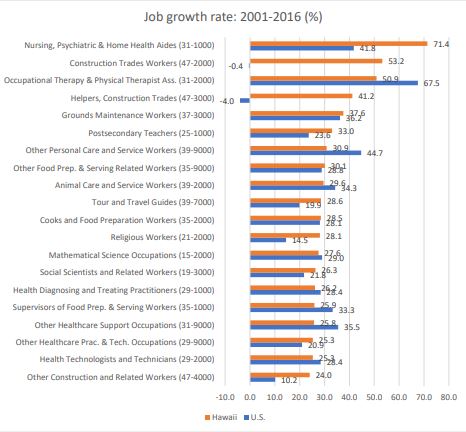
Top 20 fastest-growing occupations in Hawaii: 2001-2016. PC: EMSI, calculated by DBEDT via DBEDT.
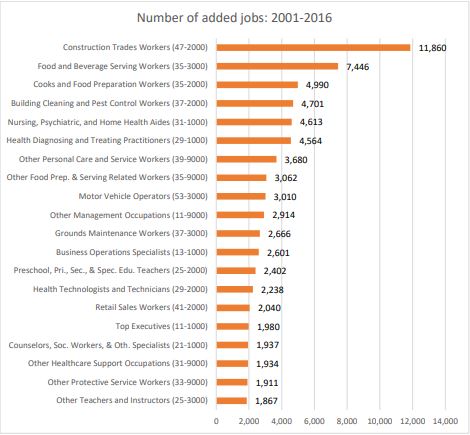
Top 20 largest-growing occupations in Hawaii: 2001-2016. PC: EMSI, calculated by DBEDT.
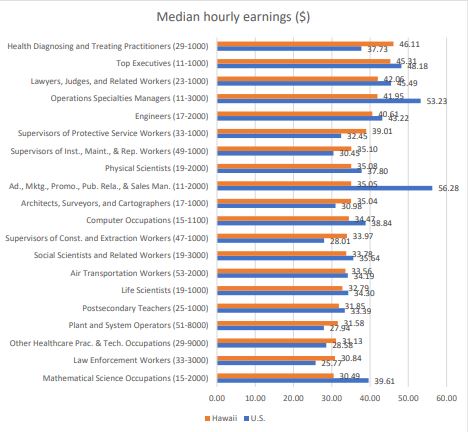
Top 20 highest-paying occupations in Hawaii: 2017. PC: EMSI, calculated by DBEDT.

Top 20 occupations by race in Hawaii: 2012-2016. PC: U.S. Census Bureau, 2012-2016 American Community Survey 5-Year Estimates via DBEDT.
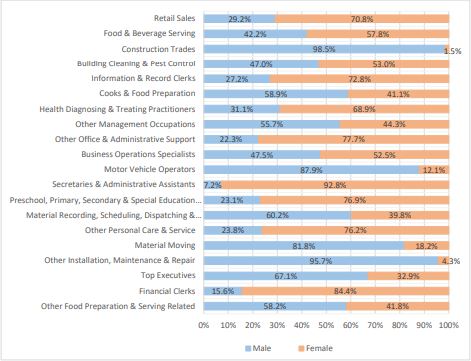
Top 20 occupations by gender in Hawaii: 2012-2016. PC: U.S. Census Bureau, 2012-2016 American Community Survey 5-Year Estimates via DBEDT.
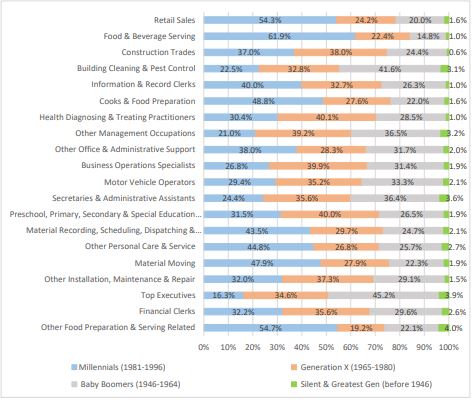
Top 20 occupations by age group in Hawaii: 2012-2016. PC: U.S. Census Bureau, 2012-2016 American Community Survey 5-Year Estimates via DEBDT.
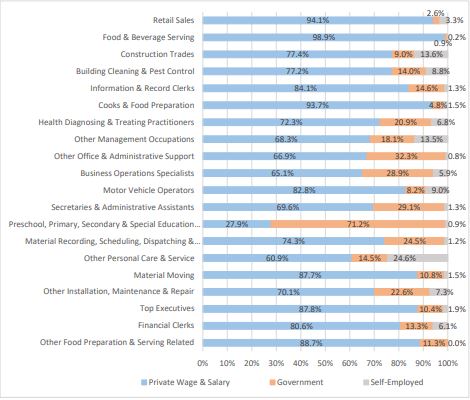
Top 20 occupations by class of work in Hawaii: 2012-2016. PC: U.S. Census Bureau, 2012-2016 American Community Survey 5-Year Estimates via DEBDT.
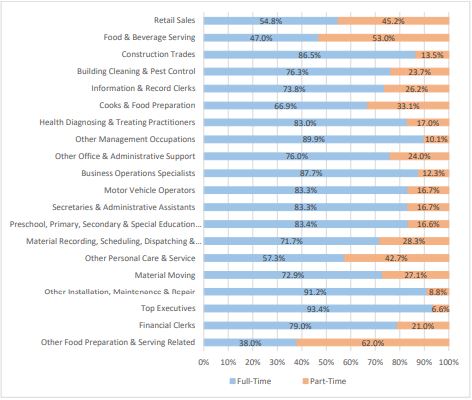
Top 20 occupations by full-time/ part-time status in Hawaii: 2012-2016. PC: U.S. Census Bureau, 2012-2016 American Community Survey 5-Year Estimates via DEBDT.
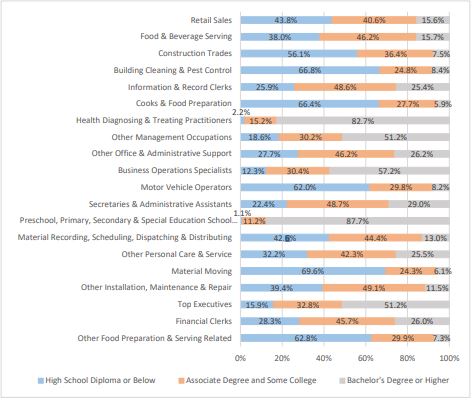
Top 20 occupations by educational attainment in Hawaii: 2012-2016. PC: U.S. Census Bureau, 2012-2016 American Community Survey 5-Year Estimates via DEBDT.












